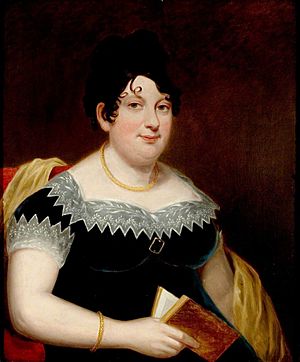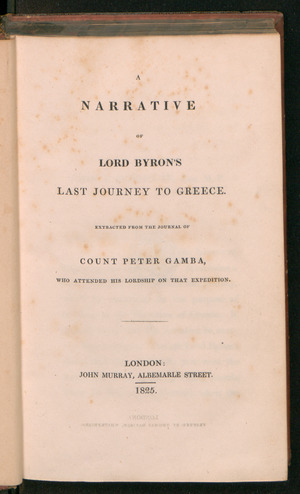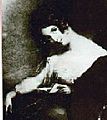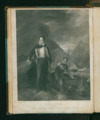Lord Byron facts for kids
Quick facts for kids
The Lord Byron
|
|
|---|---|
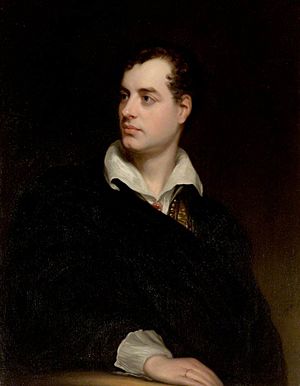
Portrait of Byron by Thomas Phillips, c. 1813
|
|
| Born | George Gordon Byron 22 January 1788 London, England |
| Died | 19 April 1824 (aged 36) Missolonghi, Aetolia, Ottoman Empire (present-day Aetolia-Acarnania, Greece) |
| Resting place | Church of St. Mary Magdalene, Hucknall, Nottinghamshire |
| Occupation | Poet, politician |
| Nationality | English |
| Education | Harrow (1801–1805) |
| Alma mater | Trinity College, Cambridge (1805–1808) |
| Literary movement | Romanticism |
| Notable works |
|
| Spouse |
Anne Isabella Milbanke
(m. 1815; separated 1816) |
| Partner | Claire Clairmont |
| Children |
|
| Relatives | Capt. John "Mad Jack" Byron (father) Catherine Gordon (mother) Vice-Admiral The Hon. John Byron (grandfather) |
| Signature | |
 |
|
George Gordon Byron, 6th Baron Byron (born January 22, 1788 – died April 19, 1824), known as Lord Byron, was an important English poet and a member of the British nobility. He was a leading figure in a creative movement called Romanticism. Many people still read his works today.
Some of his most famous poems include Childe Harold's Pilgrimage and Don Juan. Lord Byron was also well-known for his adventurous life. He even fought in the Greek War of Independence against the Turks. Sadly, he died from a fever in Messolonghi, Greece, at a young age.
He is buried in the family vault at St. Mary Magdalene Church in Hucknall Torkard, Nottinghamshire, England. A special memorial was placed for him in Poet's Corner in Westminster Abbey much later, in 1969. His daughter, Ada Lovelace, became famous for her work with Charles Babbage on an early version of the computer.
Contents
Byron's Early Life and Education
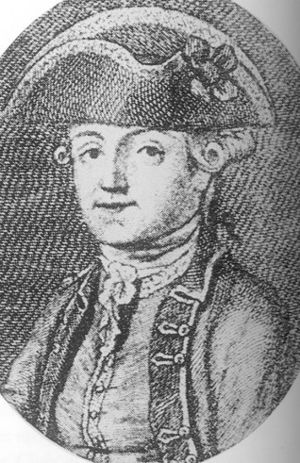
George Gordon Byron was born on January 22, 1788, in London, England. He was the only child of Captain John Byron and Catherine Gordon. His father passed away in 1791 when George was very young.
In 1801, Byron started attending Harrow School. He stayed there until July 1805. He wasn't known as a top student or a great cricketer. However, he did play in the very first Eton v Harrow cricket match in 1805. After Harrow, he continued his studies at Trinity College, Cambridge.
Byron's Adult Life and Writing Career

When he wasn't at school or college, Byron lived with his mother at Burgage Manor in Southwell, Nottinghamshire. It was there that he wrote his first collections of poems.
His long poem Childe Harold's Pilgrimage, published in 1812, became very popular. Byron himself famously said, "I awoke one morning and found myself famous." After this success, he wrote four more popular "Oriental Tales." These included The Giaour, The Bride of Abydos, The Corsair, and Lara. Other works from this time are Parisina and The Siege of Corinth.
Lord Byron traveled a lot across Europe. He lived in Italy for seven years, visiting cities like Venice, Ravenna, and Pisa. While in Italy, he often spent time with his friend and fellow poet Percy Bysshe Shelley. Later in his life, Byron joined the Greek War of Independence. He fought against the Ottoman Empire and died while leading a campaign during that war. Because of his help, Greeks honor him as a folk hero.
Byron's Death and Burial
Byron died in 1824 when he was 36 years old. He caught a fever after the first and second battles of Missolonghi.
His body was prepared for burial, but the Greeks wanted to keep a part of their hero. Some stories say his heart stayed in Missolonghi. His other remains were sent to England. Huge crowds came to see his coffin in Westminster. He was buried at the Church of St. Mary Magdalene in Hucknall, Nottinghamshire. The King of Greece later placed a marble slab above Byron's grave. His daughter, Ada Lovelace, was also buried next to him later on.
Byron's friends raised money for a statue of him. A famous sculptor named Thorvaldsen created it. However, after it was finished in 1834, many British places refused to display it. It was turned down by the British Museum, St. Paul's Cathedral, Westminster Abbey, and the National Gallery. Finally, Trinity College, Cambridge placed the statue in its library.
Byron's Family Life
Byron's Children
Byron had a daughter named Augusta Ada Byron in 1815. Her mother was his wife, Annabella Byron. Ada Lovelace became famous for her work with Charles Babbage. She helped him with his "analytical engine," which was an early version of modern computers. She is known as one of the world's first computer programmers.
Byron also had another daughter, Clara Allegra Byron. Her mother was Claire Clairmont. His third daughter, Elizabeth Medora Leigh, was born in 1814.
Byron's Interests and Hobbies
Love for Animals
Byron deeply loved animals. He was especially fond of his Newfoundland dog named Boatswain. When Boatswain got sick, Byron cared for him, even though he risked getting bitten.
Even though he was in debt, Byron had a large marble monument built for Boatswain at Newstead Abbey. It was bigger than his own planned burial spot. In his will from 1811, Byron asked to be buried with his dog. The poem "Epitaph to a Dog" is one of his most famous works.
While he was a student at Trinity College, Byron kept a tame bear. He did this because the college rules didn't allow pet dogs like his beloved Boatswain. Since bears weren't mentioned in the rules, the college couldn't stop him. Byron even joked that he would try to get the bear a college fellowship!
During his life, Byron had many pets. Besides cats, dogs, and horses, he kept a fox, monkeys, an eagle, a crow, a falcon, peacocks, guinea hens, an Egyptian crane, a badger, geese, and a heron. Most of these animals lived inside his homes in England, Switzerland, Italy, and Greece.
Swimming and the Sea
Byron loved adventure, especially anything to do with the sea. On May 3, 1810, he made a famous swim across the Hellespont Strait, from Europe to Asia. This event is often seen as the start of open water swimming as a sport. To remember it, the swim is recreated every year.
Byron's Health and Appearance
His Foot Deformity
From birth, Byron had a problem with his right foot. People often called it a "club foot." This caused him to limp, which made him feel sad and uncomfortable throughout his life. He was very self-conscious about it. He even called himself le diable boîteux, which means "the limping devil" in French. He often wore special shoes to try and hide his foot.
Byron's Physical Look
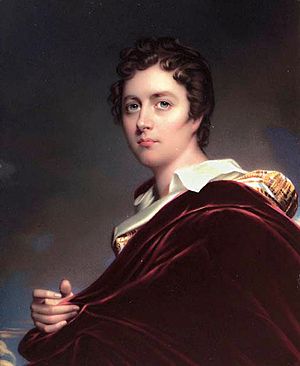
Byron was about 5 feet 9 inches (1.75 meters) tall. His weight changed a lot, but he was known for being very handsome. He even used curl-papers in his hair at night to make it look better. He was also athletic. He was a good boxer and horse-rider, and an excellent swimmer. He took boxing lessons from a famous fighter named 'Gentleman' John Jackson.
Byron was very careful about what he ate. When he started at Cambridge, he went on a strict diet to control his weight. He also exercised a lot. For much of his life, he was a vegetarian. Sometimes, he would only eat dry biscuits and drink white wine for days.
Byron's Political Interests
Byron became a member of the House of Lords on March 13, 1809. He was a strong supporter of social change. He was especially praised for being one of the few members of Parliament to defend the Luddites. These were workers in Nottinghamshire who destroyed textile machines because the machines were taking their jobs. Byron was against giving the death penalty to these "frame breakers."
He also disagreed with the official religion because he felt it was unfair to people of other faiths. These experiences led Byron to write political poems. Examples include Song for the Luddites (1816) and parts of The Age of Bronze. He also wrote poems that criticized his political opponents.
Byron's Poetic Works
Byron wrote a lot of poetry. His publisher, John Murray, released his complete works in 14 volumes in 1832. A large collection of his works, including early editions and handwritten notes, is kept at the National Library of Scotland in Edinburgh.
The Byronic Hero
Many of Byron's poems feature a character known as the Byronic hero. Byron himself is thought to be a good example of this type of character. The idea of the Byronic hero was very popular during the Romantic movement in the 1800s. It influenced many writers and artists, including the Brontë sisters.
A Byronic hero is an ideal, but flawed, character. They often have great talent and strong feelings. They dislike society and its rules. They don't care much for high social status, even if they have it themselves. They might be unlucky in love or face challenges because of society. They are often rebellious, may live in exile, and have a mysterious past. They can also be arrogant or overconfident. Ultimately, they often act in ways that harm themselves. These types of characters are now common in books and politics.
Byron's Legacy and Honors
The Greek form of "Byron," which is Βύρων, is still a popular boy's name in Greece. A suburb of Athens is even named Vyronas in his honor.
In 1969, 145 years after Byron's death, a memorial was finally placed for him in Westminster Abbey.
Near the center of Athens, Greece, there is a statue showing Greece as a woman crowning Byron. This statue was made by French sculptors. Since 2008, April 19, the anniversary of Byron's death, has been celebrated as "Byron Day" in Greece.
Byron had a big impact on literature and art in other European countries. His reputation as a poet is often higher in many parts of Europe than in Britain or America. Many composers were also inspired by Byron's writings. More than forty operas are based on his works. His poetry was set to music by famous composers like Beethoven, Schubert, Rossini, and Mendelssohn.
In April 2020, Byron was featured on a series of UK postage stamps. These stamps honored the Romantic poets on the 250th anniversary of William Wordsworth's birth. Byron's poem "She Walks in Beauty" was chosen for his stamp.
Byron's Major Works
- Hours of Idleness (1806)
- English Bards and Scotch Reviewers (1809)
- Childe Harold's Pilgrimage (1812–1818)
- The Giaour (1813)
- The Bride of Abydos (1813)
- The Corsair (1814)
- Lara (1814)
- Hebrew Melodies (1815)
- The Siege of Corinth (poem) (1816)
- Parisina (1816)
- The Prisoner Of Chillon (1816)
- The Dream (1816)
- Prometheus (1816)
- Darkness (1816)
- Manfred (1817)
- The Lament of Tasso (1817)
- Beppo (1818)
- Mazeppa (1819)
- The Prophecy of Dante (1819)
- Marino Faliero (1820)
- Sardanapalus (1821)
- The Two Foscari (1821)
- Cain (1821)
- The Vision of Judgement (1821)
- Heaven and Earth (1821)
- Werner (1822)
- The Deformed Transformed (1822)
- The Age of Bronze (1823)
- The Island (1823)
- Don Juan (1819–1824; unfinished when he died)
- So, we'll go no more a roving
- The First Kiss of Love (1806)
- Thoughts Suggested by a College Examination (1806)
- To a Beautiful Quaker (1807)
- The Cornelian (1807)
- Lines Addressed to a Young Lady (1807)
- Lachin y Garr (1807)
- Epitaph to a Dog (1808)
- She Walks in Beauty (1814)
- When We Two Parted
Images for kids
-
Ada Lovelace (1815–1852), Byron's daughter
-
Byron's visit to San Lazzaro as depicted by Ivan Aivazovsky (1899)
-
"Byron's Grotto" in Porto Venere, Italy, named in his honour, because according to a local legend he meditated here and drew inspiration from this place for his literary works
-
Statue of Lord Byron in Athens
-
Lord Byron in Albanian dress by Thomas Phillips, 1813. Venizelos Mansion, Athens (the British Ambassador's residence).
-
The reception of Lord Byron at Missolonghi
-
Stained glass at Ottawa Public Library featuring Charles Dickens, Archibald Lampman, Sir Walter Scott, Byron, Alfred, Lord Tennyson, William Shakespeare, and Sir Thomas Moore
See also
 In Spanish: Lord Byron para niños
In Spanish: Lord Byron para niños


